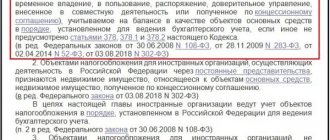Basis and legal basis
Water tax is a federal direct tax, the legal basis of which is laid down in Chapter 25.2 of the Tax Code of the Russian Federation.
This chapter, and with it the water tax itself, was introduced in 2005. Before this time, there was another tax - a fee for the use of water bodies, which was paid on the basis of the Federal Law of May 6, 1998 N 71-FZ “On fees for the use of water bodies” (now this law has lost force). Since 2007, a new Water Code came into force, which narrowed the circle of water tax payers by abolishing the licensing system for the use of surface water bodies. The right to use such objects is now acquired on the basis of a water use agreement or a decision to provide water objects for use, that is, within the framework of contractual civil legal relations. And for the use of a water body or part of it, a non-tax fee is charged - it’s called a fee for the use of water bodies. Article 333.8 of the Tax Code has also undergone changes in connection with these innovations - it has been supplemented with a clause according to which organizations engaged in water use on the basis of agreements or decisions on the provision of water bodies for use, concluded and adopted after the entry into force of the Water Code of the Russian Federation, are not recognized as payers of water tax .
We can say that the water tax is gradually being replaced by a non-tax payment for the use of water bodies.
Who pays for what?
Water tax refers to direct taxes, the proceeds of which are sent directly to the state treasury. Payers are organizations and individuals who use bodies of water in activities that require licensing. These include:
- water intake;
- use of water areas of reservoirs;
- hydropower;
- timber rafting in rafts and bags.
Legal entities and individuals who use water bodies under a water use agreement do not have to pay VN.
Such agreements must be concluded and adopted after the introduction of the Water Code of the Russian Federation dated 06/03/2006 No. 74-FZ VN is not charged for 15 types of activities. Here are a few of them:
- watering farmland, fields and pastures;
- fire fighting;
- creation of summer camps and sanatoriums;
- use of nearby areas as hunting and fishing grounds.
Taxpayers
Taxpayers of water tax are organizations and individuals engaged in special or specific water use in accordance with the legislation of the Russian Federation, recognized as an object of taxation.
Organizations and individuals who use water on the basis of water use agreements or decisions on the provision of water bodies for use, respectively, concluded and adopted after the entry into force of the Water Code of the Russian Federation (it came into force on January 1, 2007) are not recognized as taxpayers.
The Water Code provides for two grounds for the use of water bodies: a water use agreement and a decision to provide a water body for use.
a fee of the same name is charged on the basis of an agreement .
What exactly is water tax paid for?
Art. 333.8 of the Tax Code of the Russian Federation gives the exact wording of the water tax payer. First of all, these are organizations and individuals (including individual entrepreneurs) using water bodies in activities that require special permission (the so-called special water use).
Special water use is considered to be the use of various types of technical equipment, tools, and buildings for conducting primary activities on the mentioned water bodies. In order for this activity to be considered legal, a special license is issued based on the provisions of the RF CC.
Although the Tax Code of the last decade no longer contains such a term as special water use, its use well conveys the essence of the definition of the payer of this type of tax, which was first announced in 2005 and became a replacement for the Federal Law “On Payment for the Use of Water Bodies.”
REFERENCE. Taxpayers can be enterprises and entrepreneurs who have received permission to use groundwater in their activities, which are also natural resources, but are regulated by the Russian Federation Law “On Subsoil”.
According to paragraph 2 of Art. 333.8 of the Tax Code of the Russian Federation does not include such enterprises and individuals who received water bodies for use by virtue of a relevant agreement/decision as taxpayers.
The right to make decisions is vested in the Government of the Russian Federation, municipal authorities and other executive bodies authorized to independently fix fees for water use, as well as methods for calculating and paying them. All this applies only to contracts and decisions concluded from 01/01/2007.
The water tax is a good help in a rational, careful attitude towards natural resources. This is a kind of flexible tool with the help of which an effective mechanism is created to increase the responsibility of water resource users to the ecology of the country and the whole world. The water tax helps offset the inevitable costs associated with protecting and restoring the country's ecosystems and abundant water resources.
Objects of taxation
Water tax
The following types of use of water bodies are recognized as objects of taxation by water tax:
- water intake from water bodies;
- use of water areas, with the exception of timber rafting in rafts and bags;
- use of water bodies without water intake for hydropower purposes;
- use of water bodies for the purpose of rafting wood in rafts and purses.
The following are not subject to taxation:
- abstraction from underground water bodies of water containing minerals and (or) natural medicinal resources, as well as thermal waters;
- abstraction of water from water bodies to ensure fire safety, as well as to eliminate natural disasters and the consequences of accidents;
- water intake from water bodies for sanitary, environmental and shipping releases;
- intake of water from water bodies by sea vessels, inland and mixed (river-sea) vessels to ensure the operation of technological equipment;
- abstraction of water from water bodies and use of water areas for fish farming and reproduction of aquatic biological resources;
- use of water bodies for navigation on ships, including small boats, as well as for one-time landings (take-offs) of aircraft;
- use of the water area of water bodies for the placement and parking of swimming facilities, placement of communications, buildings, structures, installations and equipment for carrying out activities related to the protection of water and aquatic biological resources, protection of the environment from the harmful effects of water, as well as the implementation of such activities on water bodies ;
- use of the water area of water bodies for state monitoring of water bodies and other natural resources, as well as geodetic, topographical, hydrographic and survey work;
- use of the water area of water bodies for the placement and construction of hydraulic structures for hydropower, land reclamation, fishery, water transport, water supply purposes and for drainage purposes;
- use of water areas for organized recreation by organizations intended exclusively for the maintenance and service of disabled people, veterans and children;
- use of water bodies for dredging and other work related to the operation of navigable waterways and hydraulic structures;
- use of water bodies to meet the needs of national defense and state security;
- abstraction of water from water bodies for irrigation of agricultural lands (including meadows and pastures), watering of horticultural, gardening, summer cottage land plots, land plots of citizens' personal subsidiary plots, for watering and servicing livestock and poultry, which are owned by agricultural organizations and citizens;
- abstraction of mine and collector-drainage waters from underground water bodies;
- use of water bodies for fishing and hunting.
Payment for the use of water bodies
The list of grounds for providing water bodies for use on the basis of an agreement (for which a fee is charged for the use of water bodies) is established in Art. 11 of the Water Code:
- intake (withdrawal) of water resources from surface water bodies;
- use of water areas, including for recreational purposes;
- use of water bodies without abstraction (withdrawal) of water resources for the purpose of producing electrical energy.
Other types of water use are provided for use either on the basis of decisions, or do not require either the conclusion of an agreement or a decision at all.
Tax rates
Water tax rates are listed in Article 333.12 of the Tax Code of the Russian Federation. They are different and depend on:
- from the object of taxation;
- from river basins, lakes, seas;
- from economic regions.
See the table for a list of all possible bets.
If different rates are established for one water body, determine the tax base separately for each rate. For example, if an organization collects water from the Volga River in the Northern and Northwestern economic regions, the tax base must be calculated separately. Despite the fact that there is only one water body - the Volga River, different water tax rates apply in these areas.
This is indicated in paragraph 1 of Article 333.10 and subparagraph 1 of paragraph 1 of Article 333.12 of the Tax Code of the Russian Federation.
Please note that a coefficient is applied to water tax rates. Its size is set for each year. For example, in 2016, bets are applied with a coefficient of 1.32.
In addition, rates need to be increased additionally in two cases .
The first is when drawing water:
- by a factor of 1.1, if you do not have special instruments to measure the amount of water that is withdrawn from the water body;
- five times for an over-limit fence.
The second is for the extraction of groundwater for its processing, packaging and sale by a factor of 10. This case does not apply to the extraction of industrial, mineral and thermal waters.
Such rules are provided for in paragraphs 1.1, 2, 4 and 5 of Article 333.12 of the Tax Code of the Russian Federation.
When multiplying bets by odds, round them to the nearest ruble. This is stated in the letter of the Federal Tax Service of Russia dated January 22, 2020 No. GD-4-3/721.
Tax base for water tax
The tax base for water tax is determined depending on the type of water use and for each water body separately:
- when withdrawing water, the tax base is determined as the volume of water taken from a water body during the tax period based on the readings of water measuring instruments, and in their absence - according to water consumption standards;
- when using water areas, the tax base is determined as the area of the provided water space according to the license, and in case of its absence - according to the technical and design documentation;
- when using water bodies without water intake for hydropower purposes, the tax base is determined as the amount of electricity produced during the tax period;
- When rafting timber in rafts and purses, the tax base is determined as the product of the volume of wood rafted during the tax period, in thousands of cubic meters. meters and rafting distance in km, divided by 100.
Let us draw your attention once again - the tax base is calculated for each water body separately! This means that, for example, when water is withdrawn from several rivers, the tax base is calculated for each river. And it doesn’t matter that tax rates for these river basins may be the same. If different rates are established for a water body, the tax base is determined in relation to each tax rate.
Water tax in tax accounting
The reflection of water obligations in tax accounting depends on the tax regime chosen by the company. Let's consider two situations:
General tax regime
Art. 264 of the Tax Code of the Russian Federation allows water obligations to be included in other expenses associated with the manufacture and sale of products. In accounting they are written off to account 91.2. When determining the tax base, they can be fully deducted.
The moment at which costs for paying water tax are accounted for depends on the cost recognition method chosen by the company:
- Cash – accrued amounts are recognized as an expense on the day of actual payment of funds to the state treasury.
- Accrual method - expenses are recognized on the last day of the corresponding quarter. For example, liabilities for the 2nd quarter reduce the tax base in the second quarter.
The amounts of budget transfers for water obligations are reflected in the income tax return.
simplified tax system
The special tax regime does not relieve the company from the obligation to remit water tax. If a commercial structure operates under the “Revenue” object, the amounts of “water” transfers to the budget do not affect the amount of “simplified” obligations.
If a company or individual entrepreneur has chosen the object “Income reduced by expenses,” “water” transfers must be included in the latter. They will reduce the tax base when calculating the “simplified” tax.
Payment base for fees for the use of water bodies
Rates, the procedure for calculating and collecting fees for the use of water bodies are established depending on the owner of the water body: by the Government of the Russian Federation, state authorities of the constituent entities of the Russian Federation or local governments.
For water bodies that are federally owned, these issues are regulated by the Decree of the Government of the Russian Federation of December 14, 2006 N 764. According to it, the payment base is established in the water use agreement for each type of use of water bodies and is determined separately for each water body or part thereof.
The payment base is:
- for payers who withdraw water resources from water bodies or parts thereof - the volume of permissible withdrawal of water resources, including the volume for transfer to subscribers, for the payment period;
- for payers using water bodies or parts thereof without withdrawing water resources for hydropower purposes - the amount of electricity produced during the payment period;
- for payers using water areas of water bodies or parts thereof - the area of the provided water area of the water body or part thereof.
If water bodies are owned by a constituent entity of the Russian Federation, then the rules for them must be established by that same constituent entity.
Water intake
If you use a water body to collect water, the tax base corresponds to the volume of water collected per quarter. Determine the volume based on the data from the measuring instruments. Record the same readings in the primary water use log. The form of the journal was approved by order of the Russian Ministry of Natural Resources dated July 8, 2009 No. 205.
But what if there are no water measuring instruments? Then determine the volume of water based on the actual operating time and productivity of the technical equipment. For example, when water is collected by a pump, the tax base depends on the pump’s performance (the volume of water taken per unit of time) and its operating time. Also take into account the height of the water rise (water column), its characteristics, which depend on time and depth, as well as the condition of the well.
If it is impossible to determine the volume using this method, use water consumption standards. The limit is specified in the license. It is established for each water body and purpose of use.
Such rules are contained in paragraph 2 of Article 333.10 of the Tax Code of the Russian Federation.
Tax and payment periods
The tax period for water tax is quarterly.
Accordingly, it is necessary to pay the water tax and submit reports on it quarterly (no later than the 20th day of the month following the reporting quarter).
As for fees for the use of water bodies , the rates, procedure for calculating and collecting such fees are established depending on the owner of the water body by the Government of the Russian Federation, state authorities of the constituent entities of the Russian Federation or local governments.
For federally owned water bodies, the payment period is a quarter and is paid at the place of use of the water body no later than the 20th day of the month following the expired payment period.
Example 1. Calculation of water supply when drawing water from underground water bodies (Neva) within the limit
A licensed organization collects water for production needs. The well is located in the Neva basin. Measuring instruments for water intake purposes are available. Let’s say that the water use limit (for the quarter) is 32 thousand rubles, and the organization for the second quarter made a withdrawal within the established limit.
Based on the given data, the VN payable is calculated as follows: 32,000 * 348 rubles. / 1000 cu. m. * 2.01 = 22,383.36 rub.
The following indicators were used in the calculation: 348 rubles. (rate for water intake from the Neva), 2.01 (adjustment multiplier for 2020), volume (32 thousand rubles).
It turns out, for 2 quarts. 2020 you need to pay VN in the amount of RUB 22,383.36. The organization's accounting displays the corresponding transactions using standard transactions: DT 20 KT 68 (accrual of VN), and then - DT 68 KT 51 (transfer of VN to the budget).
Water tax rates and fees for the use of water bodies
Water tax rates are set for river basins, lakes, seas and economic regions in rubles per 1 thousand cubic meters. water taken from surface or underground water bodies - Art. 333.12 of the Tax Code of the Russian Federation.
Since 2020, water tax rates have been indexed to 1.52. These changes were introduced into the Tax Code by Federal Law No. 366-FZ of November 24, 2014, which provides for annual indexation of tax rates until 2025. When water is withdrawn in excess of the established quarterly (annual) water use limits, tax rates for such excess are set at five times (also taking into account the coefficient of 1.52 in 2017).
The tax rate for water withdrawal for water supply to the population in 2017 is set at 107 rubles per thousand cubic meters of water taken from a water body.
Rates of payment for the use of water bodies, as well as the procedure for its calculation and payment, are established depending on the owner of the water body by the Government of the Russian Federation, state authorities of the constituent entities of the Russian Federation or local governments. For water bodies that are federally owned, payment rates for the use of water bodies are established by Decree of the Government of the Russian Federation of December 30, 2006 N 876.
The fee rates for the use of water bodies owned by St. Petersburg are approved by St. Petersburg Government Decree No. 1007 dated August 17, 2007, and are:
- For the withdrawal of water resources from surface water bodies located within the boundaries of the Neva basin, within the limits of permissible withdrawal established by the water use agreement - 258 rubles. for 1 thousand cubic meters m of water resources.
- For the withdrawal of water resources from surface water bodies located within the boundaries of the river basins of the Baltic Sea basin (with the exception of the Neva), within the limits of permissible withdrawal established by the water use agreement - 282 rubles. for 1 thousand cubic meters m of water resources. Z
- For the withdrawal of water resources from surface water bodies for drinking and domestic water supply to the population within the limits of permissible withdrawal established by the water use agreement - 70 rubles. for 1 thousand cubic meters m of water resources.
- For the use of surface water bodies or their parts - 33.96 thousand rubles. for 1 sq. km of used water area per year.
What is a water tax
The water tax is a specialized fee introduced only in 2005. It acted as a replacement for the fee that entrepreneurs using water bodies in the process of work were required to pay.
This tax is represented by a federal fee levied on companies and entrepreneurs who use the relevant water resources in the process of work. It is additionally taken from individuals if it is established that they use water bodies.
Main characteristics of the tax regime
For correct calculation, it is important to study its main characteristics. These include:
- Taxpayers. These include companies, individuals or individual entrepreneurs who use water resources in the process of work, and therefore are required to pay the appropriate amount of money for this process.
- Objects. It consists of licenses obtained by companies or entrepreneurs so that they have the opportunity to use water resources or special facilities.
- The tax base. It is represented by a valuation of a particular water body, so its size depends entirely on how exactly this object is used by a company or individual entrepreneur.
- Taxable period . It is represented by a quarter. You can read about the deadlines for filing a tax return for different types of taxes here.
- Bid. It completely depends on how exactly the water body is used, as well as in what economic zone it is located. If the main purpose of using water is to provide it for use by the population, then a tax equal to 81 rubles is charged for water use. for 1 thousand cubic meters.
- Objects of taxation. The objects are: water intake, the use of various water resources, the use of water in the field of hydropower and other methods of using resources for different purposes.
Important! Often, several tax rates are established for one water body, so the amount that the taxpayer must pay is calculated by adding up all the obtained indicators.
Rates are set in rubles per 1 thousand cubic meters. m. The size of these rates depends entirely on the economic zone in which the entrepreneur operates. During the calculation process, only rubles are necessarily used, so pennies are not taken into account.
You can see the procedure for calculating and paying the water tax in this video:
Important! Taxpayers are required to make their own calculations to determine the amount to be paid to the budget.
Payment is made in the region where the company or individual entrepreneur is located (at the legal address). Funds are transferred before the 20th day of the month following the reporting period. The legislation does not provide for the possibility of providing any benefits for this tax.
Who acts as a tax payer
The taxpayers are entities that use any water bodies in the process of work. Resources not only of seas, rivers or lakes, but also of underground springs, streams or swamps and canals can be used.
Important! Each entity using water resources must necessarily have a license, and it is possible to replace it with a special agreement concluded with the authorities.
It is illegal to use any water resources without permits. The obligation to pay tax does not cease if the license expires, while the company or individual entrepreneur continues to use water resources.
Each organization is required to pay this tax if it uses water bodies, and there is no opportunity for any company to use benefits.
When is water tax paid? Photo: www.myshared.ru
Regulation of payment of this tax
In the process of using water resources, each company must take into account the basic requirements of legislation in this area of activity. These include:
- All subjects of water tax are established by law, therefore entrepreneurs are obliged to carefully study this information so that problems with inspections do not arise;
- activities must be carried out only with a properly executed license, which can be replaced by a special agreement, and even if these documents expire, the need to pay tax does not cease;
- There are no benefits when paying water tax, therefore all entrepreneurs using water resources in the process of work are obliged to transfer funds to the state in full.
Important! Violation of any legal requirements is the reason for the accrual of fines, as well as the application of other penalties, which may even include a ban on business activities.
Procedure and terms of payment, reporting
The taxpayer must calculate the amount of water tax independently.
The total tax amount is the result of adding the tax amounts calculated for all types of water use.
The tax amount based on the results of each tax period is paid at the location of the taxable object no later than the 20th day of the month following the expired tax period - that is, April 20, July 20, October 20 and January 20, 2020. At the same time, it is necessary to submit a tax return for water tax (it must be submitted to the tax authority at the location of the taxable object).
The water tax is fully credited to the federal budget.
Foreign persons paying water tax must submit a copy of the tax return to the location of the authority that issued the water use license within the deadline established for payment of the tax.
The tax return was approved by order of the Ministry of Finance of the Federal Tax Service of Russia dated November 9, 2015 N ММВ-7-3/ [email protected] It can be submitted both in paper and electronic form - at the choice of the taxpayer. As for the fee for the use of water bodies, the procedure for its payment is established depending on the owner of the water body by the Government of the Russian Federation, state authorities of the constituent entities of the Russian Federation or local governments.
For federally owned water bodies, it is established that payment is made at the place of use of the water body no later than the 20th day of the month following the expired payment period (quarter). It is credited to the federal budget in accordance with the budget legislation of the Russian Federation.
In St. Petersburg, the fee must also be paid no later than the 20th day of the month following the reporting quarter, but this fee is already credited to the budget of St. Petersburg.
As for reporting on fees for the use of water bodies, neither the Water Code nor the adopted Government Resolutions provide for the provision of calculations or any reporting documents by payers.
Please pay attention!
Taxpayers whose average number of employees for the previous calendar year exceeds 25 people, as well as newly created organizations whose number of employees exceeds the specified limit, submit tax returns and calculations only in electronic form.
More information about submitting electronic reporting
A complete list of federal electronic document management operators operating in a certain region can be found on the official website of the Office of the Federal Tax Service of Russia for the constituent entity of the Russian Federation.
Features of paying water tax
Each company that is required to pay water tax must understand the specifics of this process. These include:
- The tax base. A single base and rate are not established, which is considered specific to this payment. The size of the base depends on different conditions. The volume of water used is taken into account, for which measurements are made with special instruments or standards are applied.
- Bid. The number of bets used is huge, so every entrepreneur should know how to choose the right bet. To do this, the type of water use, the location of the object, since it can be underground or above ground, the economic zone in which the activity is carried out, as well as the type of object are taken into account.
- The tax period is quarterly, therefore tax payment is made quarterly until the 25th day of the month following this quarter.
Important! Most often, taxpayers use special limits established by law, which makes it easy to determine the tax base without the need to make complex measurements.
Calculation rules
Taxpayers must independently carry out calculations on the basis of which the optimal amount of funds that should be transferred to the budget is determined.
Groups of taxable objects.
To determine the correct tax amount, you need to have the following information:
- tax rate;
- the tax base.
Important! Often one company uses several water bodies at once, and for each such object the tax amount must be determined, after which all the resulting values are added together.
You can read how to open your own drinking water production business and whether you need to obtain a license and pay taxes here.
For example, a company has issued a license for water intake, and the limit per quarter is 340 thousand cubic meters. m. During the first quarter, water intake was equal to 320 thousand cubic meters. m. The tax rate is 300 rubles, and the coefficient to the rate is 1.32%. In this case, the tax amount is calculated - 320,000 * 300 * 1.32 = 126,720 rubles.
How to fill out the declaration correctly
It is important not only to correctly calculate and pay the tax on time, but also to take care of the preparation of the declaration, since for its late submission or for the presence of errors in it, a certain responsibility for taxpayers is also assumed.
Important! The declaration contains information received directly by the taxpayer, which includes the rate used, the calculated tax amount and the tax base.
Rules and procedure for filling out a tax return for water tax.
The declaration is submitted quarterly with the simultaneous payment of tax. It is important that it is submitted before the 20th day of the month following the end of the reporting quarter. The declaration must be submitted to the Federal Tax Service, located at the location of the company.
It is important to correctly format and fill out the document, for which certain requirements are taken into account:
- it can be transmitted in written or electronic form, and an electronic version is required if the organization officially employs more than 25 people;
- if you plan to submit documentation in writing, then it must be filled out only with a black or blue ballpoint pen;
- all figures are indicated in rubles excluding kopecks;
- each cell is intended to record one character, which is not only a number, but also commas or periods;
- The document must contain the date it was completed, the signature of the taxpayer and the seal of the organization;
- if there are empty cells, then a dash is placed in them, and it can also be replaced with a zero;
- if any corrections are required to be made to the finished document, they must be certified by the taxpayer’s signature and the company’s seal;
- The TIN of the company or individual is entered at the top of each page of the declaration.
Sample of filling out the declaration.
The declaration certainly contains information about the correctly calculated tax base, the rates used, the number of water bodies used by the taxpayer and the correctly determined amount of water tax.
Important! If in one tax period the taxpayer did not use any water bodies, then there is no tax base, therefore no tax is paid, but the company must still submit a declaration, which will be zero.
Procedure for calculating water tax
The rate for the main types of water use is determined by multiplying the water tax rate specified in paragraph 1 of Art. 333.12 of the Tax Code of the Russian Federation, and all coefficients that must be taken into account for its calculation.
Water tax in 2020 is calculated using the formula:
Where:
- volume of water - volume of water within the limit specified in the license;
Attention! If the limit is set for a year, it must be divided by 4. If a daily limit is set, then to determine the quarterly limit, you need to multiply it by the number of days in the quarter (letter of the Federal Tax Service dated January 22, 2015 No. GD-4-3 / [email protected] ).
- rate - base rate, approved. Art. 333.12 Tax Code of the Russian Federation.
- 2.31 - increasing coefficient in 2020.
If water is taken above the limit, then a rate increased by an increased coefficient is applied for water taken above the limit. The formula for above-limit water intake will look like this:
An example of water tax calculation can be found here.
From 2026, the use of the coefficient will also become mandatory for the preferential water tax rate established for water withdrawal for the purpose of supplying the population.







